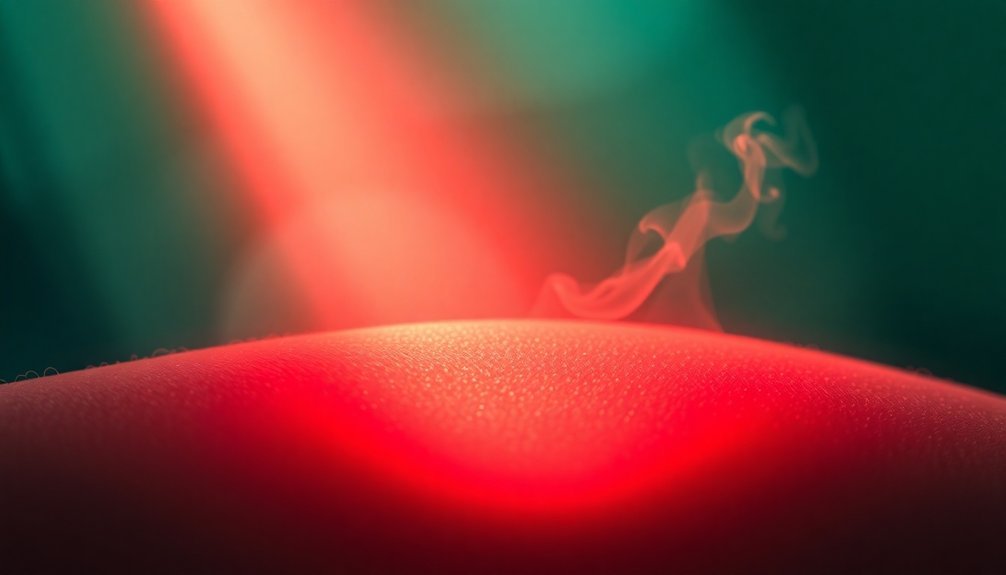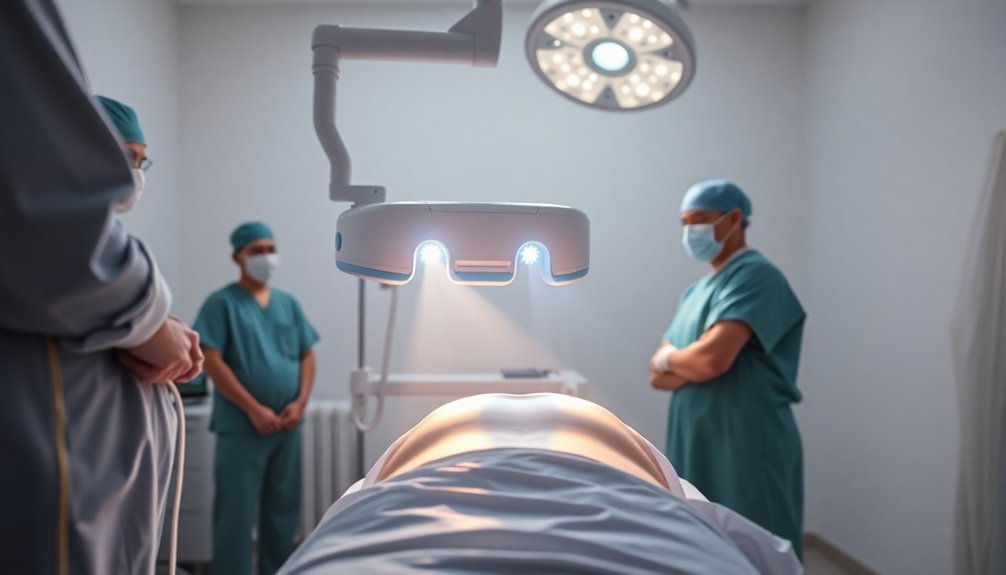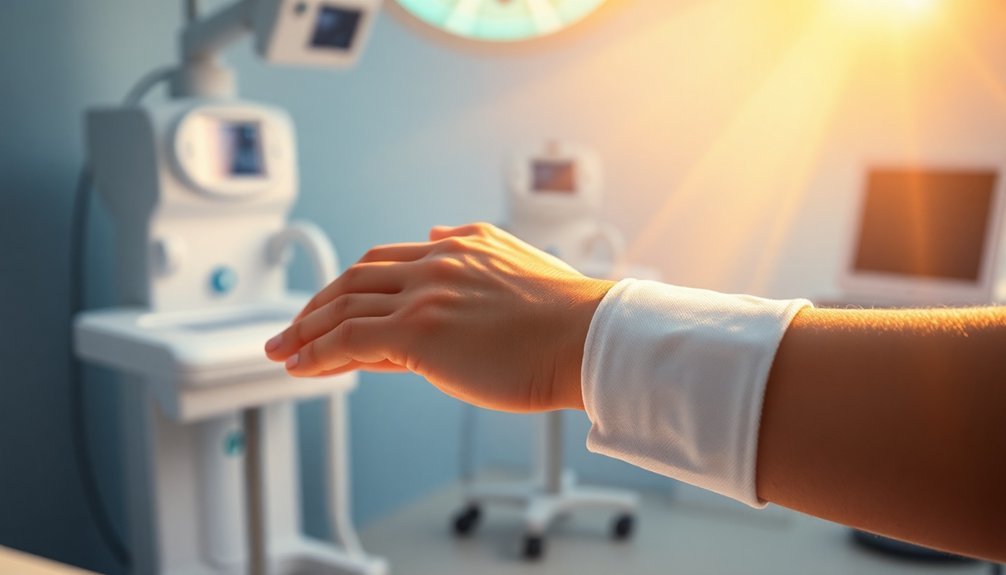You can heal surgery wounds faster using natural wavelengths like red light therapy. This method accelerates healing by stimulating tissue regeneration and enhancing blood flow. It boosts mitochondrial activity, leading to quicker cellular repair and less inflammation. Clinical studies show that patients experience reduced pain and faster recovery times with this therapy. It's non-invasive and carries minimal risks, making it a safe option for post-surgery healing. By understanding how these wavelengths work and their benefits for surgical recovery, you'll discover more ways to enhance your healing process.
Understanding Red Light Therapy

Red light therapy harnesses specific wavelengths of light to promote healing and tissue regeneration, making it an effective tool for recovery after surgery. When you use this therapy, it can accelerate your healing process considerably.
You'll notice reduced pain and inflammation, while your body increases tensile strength and manages wound contraction. This therapy stimulates tissue regeneration, helping your body form new tissue more rapidly. Furthermore, accompanying this rapid healing is the production of new blood vessels, which enhances tissue oxygenation.
Moreover, red light therapy improves cellular energy and function. It enhances ATP synthesis, boosting mitochondrial activity and efficiency, which supports effective cellular responses.
You'll find that healthy inflammation is promoted, aiding in your tissue repair efforts. You'll also experience enhanced blood flow to the wounded area, which is essential for delivering nutrients necessary for healing.
Increased collagen production supports the formation of connective fibers, strengthening your skin while minimizing scar tissue appearance.
Clinical studies back up the effectiveness of red light therapy, showing positive results for various surgical scars, open incisions, and burns.
When considering this treatment approach, collaborating with your doctor is vital to determine the best dosage and duration for your recovery. Embracing red light therapy could greatly aid in your surgical recovery journey.
Mechanisms Behind Wound Healing
After a surgical procedure, understanding the mechanisms behind wound healing can greatly enhance your recovery. The process begins with hemostasis, where vasoconstriction reduces blood flow to the wound. Platelet aggregation forms a plug, and the coagulation cascade converts fibrinogen into a fibrin mesh, stopping bleeding and creating a scaffold for healing. Platelets also release growth factors to kick-start the process.
Next comes the inflammatory phase, lasting up to seven days in acute wounds. Phagocytic cells release reactive oxygen species to fight infection, while the immune system mobilizes stem cells for healing. It is vital to recognize that inflammatory cells also release growth factors to prepare the wound bed for new tissue growth.
It's essential to manage infection and necrosis during this phase, as they can complicate recovery.
The proliferation phase follows, characterized by granulation tissue formation and angiogenesis, where new blood vessels develop. Fibroblasts create contractile tissue, while epidermal cells proliferate for re-epithelialization. Skin appendages like sebaceous glands and hair follicles start to rebuild.
Finally, the remodeling phase can take weeks to years, reorganizing collagen fibers for tissue strength. While the new tissue may lack the original's strength and elasticity, understanding these mechanisms can empower you to support your body's healing journey effectively.
Benefits for Surgical Recovery

The journey to a successful surgical recovery is greatly enhanced by several key benefits that support your healing process.
First, enhancing cellular regeneration and tissue repair is essential. By increasing mitochondrial activity, your cells gain more energy, promoting faster repair. Photobiomodulation stimulates collagen production and helps create new blood vessels, ensuring your wound gets the oxygen and nutrients it needs.
Improving blood flow and nutrient delivery further accelerates your recovery. Enhanced circulation reduces swelling while delivering critical nutrients, growth factors, and repair cells right to the surgical area. This process allows for increased energy production in the affected tissues, further supporting healing.
Better lymphatic drainage clears away excess fluid and waste, facilitating a cleaner healing environment.
You'll also notice benefits regarding scarring. By promoting healthy tissue regeneration, the formation of scar tissue decreases. The remodeling of collagen increases the tensile strength of healing tissues, leading to a more organized structure.
Finally, your overall recovery and mobility improve considerably. You can expect better joint flexibility and a quicker return to normal tissue function, minimizing discomfort.
Reducing Pain and Inflammation
When you manage pain and inflammation effectively, you can speed up your recovery after surgery.
Natural pain relief methods not only keep discomfort at bay but also help control inflammation in your body.
Natural Pain Relief
Natural pain relief offers various effective strategies to reduce pain and inflammation, and incorporating essential oils, herbal remedies, and alternative therapies can make a considerable difference. When you're seeking comfort, consider the therapeutic effects of essential oils like lavender and peppermint, which are known for their pain-relieving and anti-inflammatory properties. You might find that ginger and turmeric also serve as natural allies in your journey to alleviate discomfort.
Here's a table that lists some natural options and their benefits:
| Natural Remedy | Benefits | How to Use |
|---|---|---|
| Lavender Essential Oil | Pain relief, anti-inflammatory | Diffuse or apply diluted |
| Ginger | Reduces inflammation & pain | Tea or supplements |
| Acupuncture | Alters blood flow & reduces pain | Seek a licensed practitioner |
| Capsaicin | Relief and improved quality of life | Cream or topical application |
| Yoga | Low-impact exercise & endorphin boost | Regular practice |
Incorporating these natural remedies into your routine can considerably enhance healing and comfort. Remember, always consult a healthcare professional before starting any new treatment.
Inflammation Control Benefits
Controlling inflammation plays a crucial role in reducing pain and promoting faster healing after surgery or injury. Red light therapy effectively does this by addressing both acute and chronic inflammation, common outcomes of medical procedures. It decreases oxidative stress, a major inflammatory factor, while boosting cellular energy production through increased ATP levels. This process not only speeds up healing but also reduces painful inflammatory responses.
As your body repairs itself, red light's interaction with skin cells helps manage the inflammatory phase, promoting efficient tissue recovery. This therapy enhances cell proliferation and encourages the formation of new blood vessels and connective tissues essential for healing.
With inflammation under control, you'll likely experience less pain, allowing you to engage in daily activities sooner. Clinical studies consistently show that individuals using red light therapy report less pain and faster recovery compared to those who don't.
Whether you're dealing with surgical incisions or wounds, this innovative approach can greatly enhance your healing journey. By tapping into the benefits of red light therapy, you'll minimize discomfort and improve your recovery time effectively.
Application in Surgical Settings

In surgical settings, utilizing red light therapy can greatly enhance the healing process of wounds and incisions. This non-invasive method harnesses specific wavelengths to speed up recovery by boosting blood flow, reducing inflammation, and stimulating cellular energy production.
Here are three key benefits of red light therapy in surgery:
1. Accelerated Healing: Red and near-infrared wavelengths penetrate the skin to stimulate ATP production in mitochondria, promoting faster tissue regeneration and collagen synthesis.
Clinical studies support its effectiveness, showing quicker re-epithelialization and improved granulation.
2. Pain and Inflammation Reduction: Patients experience less pain and inflammation after receiving red light therapy, which can lead to a more comfortable recovery.
The therapy modulates growth factors that assist in tissue repair.
3. Safety and Ease of Use: Red light therapy is painless and free from significant side effects.
Treatment can start as early as the first day post-surgery and requires minimal equipment, making it practical for both clinical and home settings.
Comparison With Other Light Therapies
When considering light therapies, you'll notice that penetration depth plays a vital role in their effectiveness.
While some options offer surface benefits, others penetrate deeper for more thorough healing.
Additionally, understanding the safety profiles and potential side effects can help you choose the best therapy, especially when combined with other treatments.
Penetration Depth Differences
Understanding the differences in penetration depth among various light therapies is essential for effective wound healing. Each light type has unique characteristics that influence how deep it penetrates the skin, affecting how well it can aid in recovery.
Here's a quick comparison of penetration depths:
- Red Light (600-700 nm): Generally penetrates up to 1.5 mm, with specific wavelengths like 650 nm reaching around 4.5 mm in some studies.
- Near-Infrared (NIR) Light (700-900 nm): Provides a deeper penetration, with wavelengths like 808 nm potentially reaching up to 40 mm in certain tissues.
- Far-Infrared (FIR) Light: Excels in depth, penetrating about 1.5 inches (38 mm) beneath the skin, making it effective for deeper healing.
Understanding these differences helps you choose the right therapy for your wound type. Red and NIR lights are particularly suitable for surface wounds and skin issues, while FIR might be better for deeper injuries.
Keep in mind that factors like intensity and tissue type will also impact how effectively these lights can aid in healing.
Safety and Side Effects
As you explore light therapies for wound healing, the safety and potential side effects become essential considerations. Red light therapy stands out as a non-invasive, drug-free option that minimizes risks associated with traditional treatments. Unlike other light therapies, you'll find that it has a low incidence of serious side effects, making it a safer choice for your healing needs.
Clinical studies consistently support red light therapy's safety and effectiveness, with minimal side effects reported. Most individuals tolerate it well; any side effects are typically mild and brief. You won't experience the severe reactions linked to bright light therapy, such as headaches or eye strain, which often accompany treatments aimed at mood disorders.
This therapy's specific wavelengths, ranging between 650 nm to 808 nm, target tissue repair without causing systemic impacts or significant adverse effects. Additionally, red light therapy has proven safe across various age groups, from pro athletes to seniors.
If you're cautious about how other therapies might affect you, red light therapy offers a reliable alternative with a favorable side effect profile. Regarding long-term use, studies back its continued safety without increasing risks over time.
Combined Therapy Benefits
While many light therapies offer unique benefits for wound healing, red light therapy distinguishes itself through a combination of enhanced healing capabilities and low side effects.
Compared to blue light therapy, red light therapy not only accelerates wound closure but also builds tissue strength more effectively. Here's why you might want to reflect on combining therapies for best results:
1. Enhanced Cell Proliferation: Red light therapy stimulates faster cell division and collagen production, leading to quicker recovery times.
Meanwhile, blue light's role is more limited to managing inflammation.
2. Increased Collagen Production: Red light boosts collagen and connective fiber creation, which is essential for robust healing.
Blue light primarily influences inflammation and may not support tissue strength as effectively.
3. Inflammation and Pain Management: Red light reduces both acute and chronic inflammation while alleviating pain.
Blue light helps with inflammation but doesn't address pain control as thoroughly.
Clinical Evidence Supporting Therapy

Clinical evidence underscores the effectiveness of laser therapy and photobiomodulation in enhancing surgical wound healing. For instance, a clinical study involving 72 patients with stage II and III pressure ulcers demonstrated significant healing when treated with a laser at 658 nm. This wavelength particularly aids in wound closure, while wavelengths like 808 and 940 nm have shown minimal effects.
Near-infrared light in the range of 800–830 nm has also proven valuable for repairing both acute and chronic dermal wounds. Red light (630–680 nm) positively modulates wound healing through mechanisms like increased fibroblast activation and collagen production. These wavelengths work together to reduce inflammation, promote tissue regeneration, and enhance processes like angiogenesis and epithelialization.
Advanced treatments, such as Phovia's fluorescence biomodulation, have exhibited remarkable outcomes, including improved dermal repair and increased collagen type III expression in surgical wounds. Patients experienced satisfactory healing with no adverse reactions reported, confirming safety and efficacy.
Optimizing Recovery With Red Light
Building on the powerful effects of laser therapy and photobiomodulation in wound healing, red light therapy offers another promising avenue to enhance recovery. This innovative treatment improves healing outcomes by utilizing specific wavelengths that stimulate cellular activities crucial for recovery.
Here's how red light therapy optimizes your healing process:
- Increased Cellular Energy: It enhances ATP production, energizing your cells to speed up recovery.
- Reduced Inflammation: Red light therapy minimizes both acute and chronic inflammation, relieving pain and promoting quicker healing.
- Improved Blood Flow: This therapy boosts blood circulation, ensuring vital nutrients and oxygen reach your wound site effectively.
You'll also notice faster healing rates, improved wound contraction, and reduced pain and itchiness. As new tissue forms, red light encourages collagen production, which aids in scar healing.
Keep in mind, though, it's crucial to consult with your healthcare provider for the appropriate treatment duration and dosage.
With red light therapy, you can take a significant step towards a speedy and effective recovery.
Frequently Asked Questions
How Often Should Red Light Therapy Be Applied?
For ideal results, you should apply red light therapy 5-7 times a week. Each session can last 5-20 minutes, but consistency is essential. Adjust the frequency based on your individual healing needs and goals.
Are There Any Side Effects of Red Light Therapy?
Yes, red light therapy can cause side effects like headaches, eye strain, and skin irritation. If you're sensitive or on certain medications, it's wise to consult a healthcare professional before starting treatment.
Can Red Light Therapy Be Used on All Skin Types?
Yes, red light therapy can be used on all skin types. It's generally safe and non-invasive, promoting healing and reducing inflammation while improving skin conditions. Always consult a doctor to ascertain it's suitable for your needs.
Is Red Light Therapy Safe for Children?
Yes, red light therapy can be safe for children when used correctly under healthcare supervision. Confirm treatments are brief, monitor for skin reactions, and consult a pediatrician to adjust intensity and duration appropriately.
How Long Does a Typical Red Light Therapy Session Last?
A typical red light therapy session lasts between 5 and 20 minutes, depending on your needs. For specific conditions, sessions can be as short as 30 seconds to 5 minutes, ensuring effective treatment without discomfort.
In Summary
Incorporating red light therapy into your post-surgery routine can substantially enhance your healing process. By harnessing natural wavelengths, you can speed up recovery, reduce pain, and minimize inflammation. With growing clinical evidence backing its effectiveness, this approach is a promising addition to traditional wound care. Whether you're recovering from a minor procedure or major surgery, consider embracing red light therapy to optimize your healing journey and get back to your life faster.





Leave a Reply